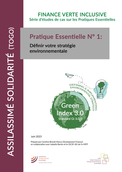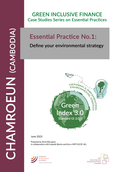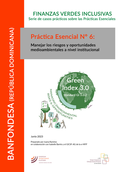The Green Index: an innovative tool to assess environmental performance of inclusive finance institution

The Green Index Framework
The Green Index (GI) is a framework for assessing the environmental performance of financial services providers (FSP) and other stakeholders in green inclusive finance and defining action plans to improve. It was developed by the e-MFP Green Inclusive and Climate Smart Finance Action Group (GICSF-AG) in 2014, being updated in 2016 (Green Index 2.0) and 2022 (Green Index 3.0).
It has been designed to be a core tool to support the inclusive finance sector’s engagement in the definition, implementation, and monitoring of environmental practices and to mainstream green inclusive finance. More than an assessment tool, the GI 3.0 provides a detailed framework to support the inclusive finance sector to:
Raise awareness and increase commitment
Assess activities
Support strategic planning
Prioritise activities
Monitor progress at institutional and sector level
Through the Green Index 3.0, an FSP’s green inclusive finance performance is analysed based on three key concepts:
Vulnerability: how clients and the institution are affected by the environment (including climate change, degradation of the ecosystems, energy poverty, etc.).
Adverse environmental impacts: how clients and the institution affect the environment (including air, water & soil pollution, GHG emissions, deforestation and land degradation, etc.).
Green economic opportunities: how green practices, products, and services can satisfy demand and increase revenue for clients or be an opportunity for the financial service provider.
The Green Index 3.0 is composed of four standards (GI.0, GI.1, GI.2, GI.3), each containing two essential practices. For each essential practice, there is a set of indicators, which assess the different actions institutions can implement.
The Green Index 3.0 provides a major step forward for the sector. It has been designed based on the experience and knowledge accumulated over the past 7 years of implementation of the previous versions of the tool, the analysis of 1.000+ environmental performance assessments, the review of, and in alignment with, existing international initiatives, standards, and reporting frameworks for ESG, environmental performance, and climate risks/finance. In the development and review of the tool in the period 2020-2021, more than 500 sector stakeholders, including GICSG-AG members, were involved in the process.
The Green Index 3.0 is moreover fully aligned with Dimension 7 (Environmental Dimension) of the Universal Standards for Social and Environmental Performance Management (USSEPM), co-developed by Cerise+SPTF and the e-MFP GICSF-AG, at the conceptual level of the standards and essential practices. The Green Index 3.0 provides an in-depth analysis and helps establish a detailed improvement action plan on green inclusive finance, while Dimension 7 of USSEPM helps establish a detailed improvement action plan in the framework of the Universal Standards.
The Green Index 3.0 resources
To know more about GI 3.0 and explore the tool, please see:
Training materials on GI 3.0
English (recording and presentation training 2022)
French (recording and presentation training 2022)
Spanish (recording and presentation training 2022)
The Digital Solution for the Green Index 3.0 is a flexible solution, freely available for the full sector. It is available in English, French, Spanish and more languages. It can be used to explore the Green Index 3.0 as a “demo”, to fill self-assessment, or to receive an expert audit.
The digital solution for the Green Index 3.0 is developed by HEDERA, IT Partner of the GICSF-AG. It has been conceptualized by Davide Forcella, Natalia Realpe Carrillo and Alfonso Caiazzo, and it has been developed by Alfonso Caiazzo (HEDERA).

If you or your organisation are interested in conducting a self-assessment or an expert assessment, please contact jafonso@e-mfp.eu, so that we can provide you with a dedicated link and database.
The GICSF-AG can provide FSPs and investors support to undergo an expert audited Green Index 3.0 assessment and receive guidelines for the improvement of their environmental performance, as well as support all sector stakeholders through trainings on the Green Index 3.0 framework and the use of the digital solutions for environmental assessment, training of trainers, and data analysis on green inclusive finance performance, among other services.
The Green Index 3.0 Case Studies – learning from the field
In 2023, as part of the development of the Green Map project , a series of case studies exploring the experience of different FSPs across the world in the implementation of a specific Essential Practice of the Green Index were developed.
We are grateful to the participating FSPs for sharing with us and the sector their experiences and to the team of consultants involved in the project that prepared the 15 case studies below.

EN - FR - ES EN - FR - ES EN - FR - ES EN - FR - ES EN - FR - ES

EN - FR - ES EN - FR - ES EN - FR - ES EN - FR - ES EN - FR - ES

EN - FR - ES EN - FR - ES EN - FR - ES EN - FR - ES EN - FR - ES
Some of these case studies as well as other resources associated with Dimension 7 of the USSEPM can be found at SPI online resource centre.
Previous editions of the Green Index
Green Index 2.0 (2016)
The Green Index 2.0, An innovative tool to assess environmental performance in the microfinance sector – e-MFP Brief No. 6, prepared by the e-MFP Microfinance and Environment Action Group under the coordination of the Group co-heads: Marion Allet (PAMIGA), Geert Jan Schuite (ENCLUDE), Davide Forcella (CERMi), Raluca Dumitrescu (MicroEnergy International), October 2016.
e-MFP Brief No.6 describes the update process of the Green Index and details the standards, essential practices and indicators of the Green Index 2.0 which were also included as an optional module in SPI4, the social performance audit tool developed by Cerise.
Green Index 1.0
The Green Index, an innovative tool to assess the environmental performance of MFIs – e-MFP Brief No. 5, prepared by Marion Allet, Pamiga in collaboration with the e-MFP Microfinance and Environment Action Group, October 2014.






























